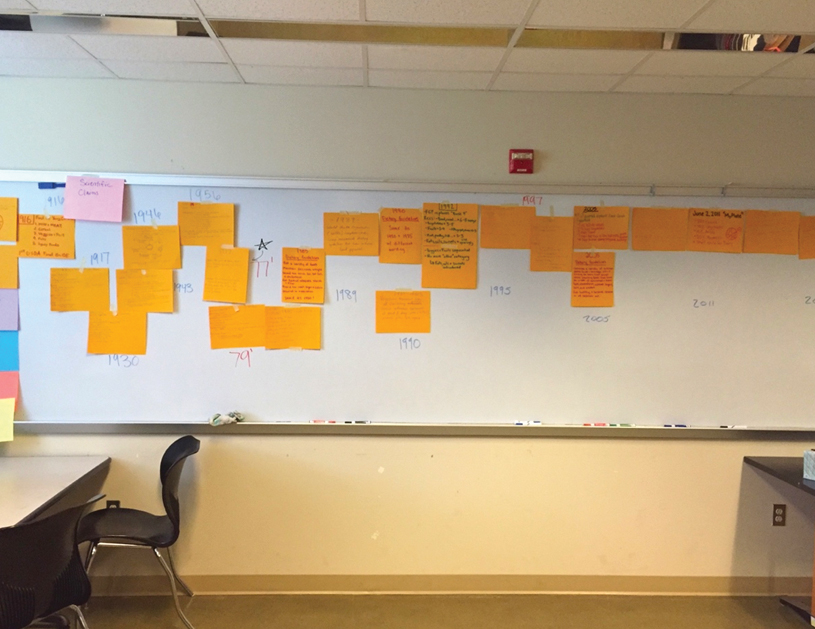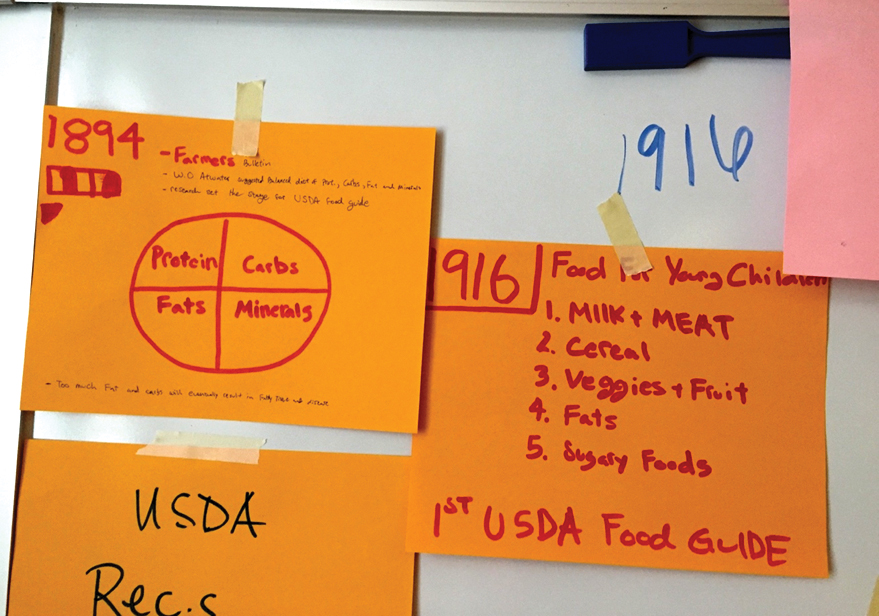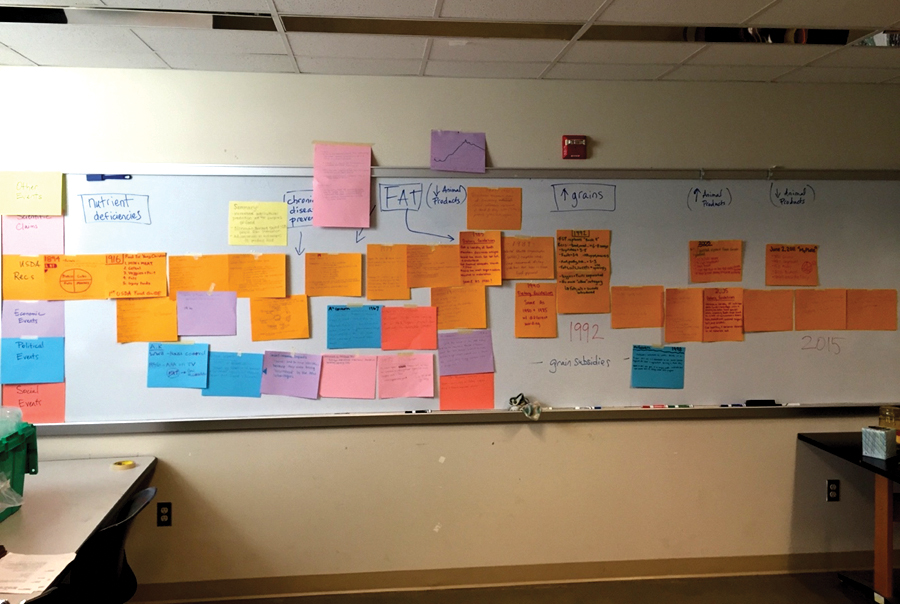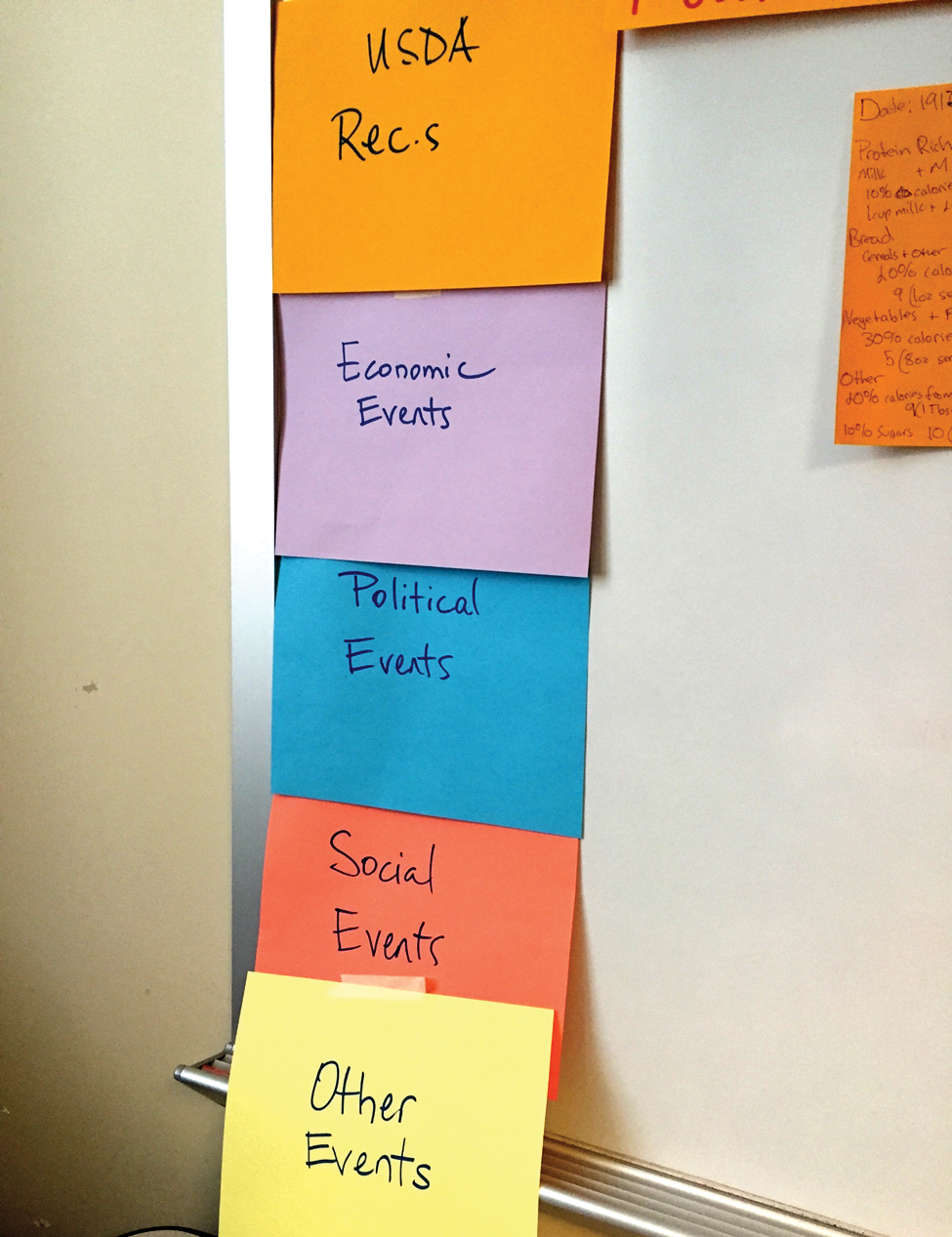Feature
Science in Socio-Scientific Issues
Teaching with a timeline activity
The Science Teacher—March 2020 (Volume 87, Issue 7)
By Jaimie A. Foulk, Patricia J. Friedrichsen, and Troy D. Sadler

Embedding science learning in real-world issues is a research-based way to generate student enthusiasm, interest, and motivation for science (Zeidler and Kahn 2014). Many decisions our students confront will require an ability to make sense of scientific ideas and information within the context of daily life. Students will face issues that pose significant consequences to themselves, their families, their communities, and their world. In science classrooms, this means that all students, regardless of future career paths, need to have meaningful science learning experiences that equip them to make informed decisions throughout their lives. While achieving the performance expectations of the Next Generation Science Standards is necessary for all students, this will not be enough.
We advocate teaching secondary science in the context of socio-scientific issues (SSI). SSI are authentic societal challenges with connections to science, such as climate change, antibiotic resistance, and fracking (Owens, Sadler, and Friedrichsen 2019; Sadler, Foulk, and Friedrichsen 2017). Because they are controversial topics, addressing SSI requires both an understanding of relevant science ideas and thoughtful consideration of an issue’s social, economic, political, and ethical aspects. For our students to become informed voters and members of society, they need experience grappling with these complex issues and seeing how science and their daily lives intersect. SSI-based units integrate relevant science ideas with social aspects of SSI and include lessons focused explicitly on each. Because of this, teaching science with SSI may require innovative instructional strategies. We developed a timeline activity that uses one such strategy to help students explore societal aspects of an SSI.
Timeline activity in an energy systems nutrition unit
We developed a timeline activity, which takes approximately two 55-minute class periods, to guide high school students in exploring societal aspects of an issue featured in an SSI curricular unit. Our unit is centered around the SSI of a proposed tax on obesogenic foods, or foods that are thought to promote excessive weight gain, and is designed to teach about energy systems through nutrition at the high school level. The “fat tax” issue serves as a context for science learning activities focused on relevant science ideas about macronutrients, nutritional pathways, and human nutritional needs. Since its first classroom use, the timeline activity has been successfully adapted for use with various topics in multiple course settings. We offer a detailed description of the timeline activity in our societal aspects lesson, as well as suggestions for use with other topics. To learn how the societal aspects lesson fits into the energy systems in sport unit, as well as how the societal aspects are integrated with relevant science ideas in the unit, see the project website.
Timeline day 1: History of nutrition recommendations
The energy systems unit begins with an ethical dilemma: Should the U.S. government consider a “fat tax” to encourage citizens to make more “optimal” nutrition choices? Students are asked to take a position on this SSI and support it with clear reasoning. The timeline activity occurs during the fifth lesson of the unit and follows explorations of cultural aspects of the issue, relevant science ideas, and an application of these ideas to students’ own nutritional choices.
On the first day of the timeline activity, students revisit the fat tax dilemma to revise their initial responses to the question, modify their positions as needed, and provide evidence and reasoning from the class activities. In addition, students respond to a new subprompt: To me, eating for good health means…. As a lead-in to the timeline, this prompt helps students articulate personal beliefs about the topic of nutritional recommendations. To challenge students’ ideas in the timeline activity, it is important to make them aware of their initial beliefs.
Next, students are divided into small groups and assigned sets of historical nutrition recommendations to investigate and summarize. Assigned topics (one to two per group) include: Atwater’s 1894 Farmer’s Bulletin No. 23 & Principles of Nutrition and Nutritive Value of Food, USDA’s Food for Young Children, Basic 7, Basic 4, U.S. Dietary Guidelines for Americans, Food Guide Pyramid, MyPyramid, and MyPlate. Each group writes its summary on a colored sheet of paper, to be posted on a wall as a collaborative timeline. In their summaries, students identify the title of recommendations, year of publication, intended demographic, apparent purpose (e.g., prevention of nutrition deficiencies, response to food availability, prevention of chronic disease, etc.), and general or notable ideas. As small groups finish their summaries, they post them on the class timeline.

When the timeline is complete and significant dates highlighted as appropriate, each group presents its findings to the class. A subsequent whole-class discussion allows students to recognize ways that target populations, emphases, and content of nutrition recommendations have changed throughout history. For example, around the turn of the 20th century, when vitamins were first being discovered, nutrition recommendations were targeted at ensuring children consumed certain foods to prevent diseases of deficiency. By World War II, the focus of nutrition recommendations shifted toward the general population, creating groups of foods to allow for appropriate substitutions, in an attempt to address overall food scarcity.
Day 1 of the timeline activity allows students to note these and other patterns throughout history, which in turn enables students to recognize the need to better understand the scientific and societal factors affecting historical nutrition campaigns (See Figures 1 and 2).
Timeline day 2: Historically significant events
Day 2 of the timeline activity opens with a question about the previous day’s work: How have your ideas about eating for good health changed since yesterday’s timeline activity? After responding to the opening prompt, the small groups reconvene to investigate and summarize historical events of nutritional significance. Topics include discovery of vitamins, World War I, the Dust Bowl, World War II, the Green Revolution, and the McGovern Committee. In addition, groups summarize some key nutritional science events, including Ancel Keys’s Seven Countries Study, the Diet-Heart Hypothesis, and the Noakes Hearing.
Student groups record summaries of their assigned events on color-coded paper, according to their classification as events of a scientific or societal nature. Societal events are further classified to specify whether they represent political, economic, social, or “other” impacts. Groups then post their summaries under the Day 1 nutrition recommendation summaries, in chronological order on the timeline.
In addition to these classifications, student groups provide title and year(s) of the event, a brief summary of the event’s main characteristics, stakeholders to whom the event was relevant, and connections of the event to human nutrition. For example,
Some events, such as the Seven Countries Study and the Diet-Heart Hypothesis, are of obvious scientific nature. Both are examples of scientific research that used medical data to draw conclusions about relationships between specific macronutrients and human physiology. Other historical events had impacts in more than one category, which can be recorded using multiple colors, as appropriate (see Figures 3 and 4).
When the timeline is complete, student groups again present their summaries of events and engage in a whole-class discussion. This enables students to recognize the changing and tentative nature of the science informing nutrition trends, as well as the profound impact of historical events on nutrition concerns, beliefs, and recommendations (see Figure 5). In our complete unit, the timeline activity naturally leads to lessons regarding current scientific understanding of chemical structures and biological functions of macromolecules, metabolic pathways, and human nutrition requirements.
Benefits of the Timeline
By constructing the timeline, students are able to make sense of key scientific, political, cultural, social, and economic events that have influenced public (and their own) perception about nutrition. Students see the influence of wars, government policy, natural disasters, and marketing on nutrition recommendations. Through engagement in this activity, students recognize various positions of stakeholders such as the food manufacturing, agriculture, and healthcare industries, as well as ways that nutrition guidelines have been influenced by key scientific studies.
Our students were remarkably enthusiastic and engaged in the topic of nutrition. Through the unit, they gained a deep understanding of the fat tax issue. To develop an informed position on the issue, they recognized the need to ask questions that require not only an understanding of science but also a deep exploration of the changing social context. This activity motivated students to apply what they learned about the structure and function of macronutrients to calculations of nutritional energy, and the reactants and products of metabolic pathways. In addition, the timeline activity revealed the impacts of nutrition on public health, as well as government intervention and nutrition policy.
NGSS Connections
The nutrition unit focused on NGSS disciplinary core ideas from life science (HS-LS1-6 and HS-LS1-7) and chemistry (HS-PS1-2 and HS-PS1-7). Throughout the nutrition unit, students engaged in the scientific practices of explanation, construction, argumentation, and scientific modeling. Energy systems were emphasized as the crosscutting concept in the unit. Nature of Science ideas such as creativity, bias, and the tentative nature of science were featured in the timeline activity.
Alternative contexts for the timeline activity
We have shared our timeline activity at a number of teacher workshops, where participants have responded favorably to the activity, shared ways they have adapted the lesson for classroom use, and have reported positive results as their students explored societal dimensions of SSI appropriate to multiple science courses. Examples of alternative uses include variations of the nutrition timeline in a cellular respiration unit for a biology course, in a food security unit for a contemporary issues course, and in a unit on performance-enhancing substances in an exercise science course. Another example features a timeline of historical events related to flooding and river management for a watersheds unit in an environmental science course.
Conclusion
Teaching science with socio-scientific issues allows students to make meaningful use of science for application to real-world decision making, rather than simply learning isolated science facts. This requires a shift in teachers’ approaches to planning and teaching, providing students focused opportunities to explore social aspects of SSIs beyond science content. The timeline activity can help teachers integrate the social, political, and economic aspects of science issues into existing curriculum units and is consistent with what we know about best practices for SSI-based teaching and learning. We encourage you to incorporate it into a science unit you teach.
For more guidance regarding teaching science with socio-scientific issues, see the [RI]2 Teaching and Learning framework at our project website.
Jaimie A. Foulk (jafoulk@mail.missouri.edu) was a science methods instructor and graduate research assistant and Patricia J. Friedrichsen is a professor of science education at the University of Missouri, Columbia. Troy D. Sadler is the Thomas James Distinguished Professor in Experiential Learning at the University of North Carolina, Chapel Hill.
Interdisciplinary Pedagogy Teaching Strategies High School






